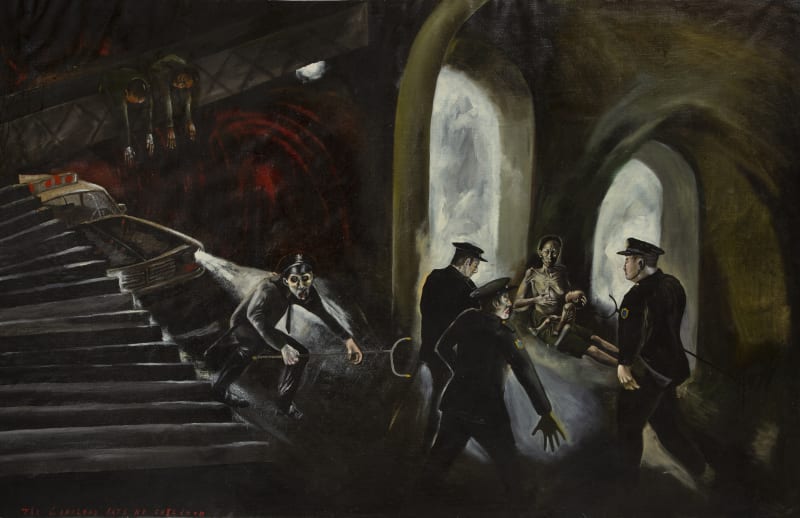This large touring exhibition is our first chance to see a major presentation of Sue Coe's work in this country. She has exhibited here in several group shows but the impact of this one woman show is immense. My only caveat about the exhibition, which has been culled in part from her 1988 American touring exhibition, is that there is quite a lot of old work, some dating from the Seventies, although this may have been a deliberate attempt on the part of the organisers to give an overview of her oeuvre. There is also no catalogue, only an expensive though well-produced book from the US show, which covers somewhat different works.
Sue Coe claims not to be a 'political artist' and to an extent this is true. She is a painter of truth, depicting things seen or visualising things known and she uses a wide range of painterly devices to present this. However, much of the work is on what is generally held to be a political theme, and no painter of humankind can avoid the fact that life (and death) = politics. In her dissection of the contemporary world she strips bare the lies, the greed, complacency and visciousness of our time and presents them as she expereinces them. It seems to me that it is a polemic art, one battering against a population which lives with its eyes closed--using the fact that people look at 'Art' (not reality)--to make them again aware of their environment. The title of the exhibition, "Police State", is not only a generic label for the world we live in, but also refers, in the painting of that name, to a specific instance of police brutality witnessed by herself and her sister at a rally in Trafalgar Square in 1985 where Jesse Jackson was speaking about South Africa. As with this painting, Coe continually forces universal principles into the concrete, the specific, and in this lies much of her bravery and the fear and terror engendered by her work.
Coe's work is not aimed at a gallery-going minority but at the public at large. She has chosen to work as a newspaper illustrator to achieve this wide audience. The work in this exhibition covers both this area and large paintings on more personal themes, such as the "Woman Raped on Pool Table" series. The work is littered with artistic, literary and musical references but with no sense of elitism--historical antecedents can be found but there is nothing lost if they are unrecognised. Her inspirations range from Goya and Rembrandt to Grosz and Brecht and her work follows the tradition of these great depictors of the human condition. She is painfully aware that 'we learn from history'; her mad woman dancing, ironically entitled "Mother and Child", is a figure out of time. She also makes reference to The Bible on the theme of the outcast, in for instance 'The Landlord Says No Children', an agonising contemporary version of The Nativity, where there is no suggestion of any salvation for the destitute and homeless. These allusions add layers of poignancy and meaning to her vision of contemporary life.
She is obsessed by certain images which recur again and again in different guises or as a series. In this show it is the theme of the helpless and vulnerable stretched on a table, ranging from the series "Woman Raped on Pool Table by a Man while 20 Men Watch" to the vivisectional images of heart surgery on baboons. "The Pool Table" series shows humanity at its most dehumanised and exploitational; the men reduced to creatures feeding on sensation; the terror and pain of the woman appearing separate, on a different plane. The victim is truly destroyed, having no voice, no presence to the onlookers. In some works this image of the table is presented as a space where the victim can make his/her only statement, as in the painting, "The Death of Bobby Sands" where the only available protest is elected martyrdom. This painting reflects the bigotry and fatalism on both sides of the Irish question.
The power of this exhibition lies in its ability to make us see, to force response. It is distressing and difficult to view because of the strength of the image and the force that Coe's technique brings to her subject. Ironically two Oxfordshre County Councillors have objected to the exhibition and to The Museum of Modern Art Oxford for hanging it--they appear unaware that the objection is to those who create and uphold the 'Police State' in all its forms. However hard, we must look at this work, understand its nature, and attempt to learn from Sue Coe's courage and clarity of vision.
Museum of Modern Art, Oxford 22 Jan.26 March; The Orchard Gallery, Deny 7 April-4 May; Herbert Art Gallery, Coventry 29 July-29 August,. Cornerhouse, Manchester 9 Sept-15 Oct
*
MAKE Magazine was the principal publication produced by Make, the organisation for women in the arts (formerly the Women's Art Library or Women Artists Slide Library prior to 1992).
Content focussed on historical and contemporary women's art practice and highlighted emerging and established artists from around the world. In addition to reviews and previews, content was made up of artists' projects, interviews and featured debates.
First published in 1983 as a newsletter for the Women Artists Slide Library, it was developed throughout the 1980s and early 1990s as a Journal and then Women's Art Magazine.
From a modest A3 document this publication culminated in a full colour 100 page final issue in 2002. The provocative stance of the magazine was established by a diverse range of editors ensuring its unique position amongst international arts publications.
